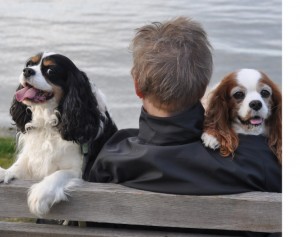 Survival of the fittest isn’t what you think it is. It depends on who you are and what you’re up to.
Survival of the fittest isn’t what you think it is. It depends on who you are and what you’re up to.
I personally would not survive if I were a wolf and had to run down an elk or a rat. I wouldn’t even want to (either survive or hunt down anything but a cherry pie). It’s icky and it’s just not me.
Plus, I know there’s an easier way to make a living. I see my dogs do it every day.
The call of the wild wolf doesn’t appeal to my dogs. They’re Cavalier King Charles Spaniels. People make fun of Cavaliers, saying things like they’re too cute to be taken seriously and not smart enough to take care of themselves.
Truth is, my Cavaliers are evolved. They may be descended from wolves, but they take their lifestyle seriously, living well choreographed, strategically planned lives that get straight to what it takes to survive modern times.
They’re mall dogs.
It doesn’t just take breeding to be a mall dog. It takes class and moxie.
You don’t hunt down anything. You act so cool it comes to you.
You don’t actually work at anything. You just assume whatever it is you want will magically appear.
It never occurs to a mall dog that there are obstacles in life. They see everything as an opportunity, some better ones than others.
Mall dogs are extroverts. My dogs, Murphy and Alki, have made that an art form. They work every opportunity, even when it isn’t one. Their philosophy is to go for it boldly, where, possibly, other dogs have rarely gone before.
Like brand new, isolated hotels that really only cater to humans.
I learned that at Christmas last year. We’d driven north from Seattle to meet a good friend from Portland we rarely get to see. The dogs hadn’t exactly been invited, but that didn’t occur to me until all three of us were out of the car, staring at the brand spanking new hotel, with its sweeping driveway, wide plant-lined entrance, and a red carpet leading straight through two large sweeping doors. As Hollywoody as it gets in north Seattle.
I was suddenly intimidated. My mall dogs were not: they were surveying their new kingdom.
I gulped. “Ah, guys,” I said, “I’m not really sure dogs are allowed here.”
They looked at me like I was a Martian, then eyeballed the doors. I may not be sure we’re always welcome in certain places, but that thought never occurs to them, unless I bring it up, which I was then doing, but they didn’t believe me, so it was pointless.
They faced the doors, evaluating the situation. Then they threw their heads up and sashayed forward, tails swishing like capes. They were in charge as only mall dogs can be: they know how to make an entrance, and they flirt their way through obstacles.
I’m easily amused. I followed their lead.
As they pranced into the pristine, high-ceilinged hotel lobby, guests and hotel clerks looked up. Gasped.
The dogs stopped and surveyed the crowd, huge grins on their adorable Cavalier faces. The gasps dissolved into giggles. Just like that, any rules we may have broken didn’t matter. The celebrity mall dogs had arrived.
Unfortunately, our friend wasn’t there. We hung out in the lobby like we belonged, the dogs winking at guests, who continued to giggle when they weren’t playing with them. Murphy and Alki monitored the doors, but ignored everyone who came through. Until our friend finally walked in.
Now, what would a wolf do in that situation, or an elk? My mall dogs barked their heads off as they bounced down the lobby and threw themselves in our friend’s arms.
More human giggling ensued. No one yelled at us, but why would they? The dogs had enthralled them (much easier than hunting). We marched to our friend’s room, had a great visit, and left in the same high-falutin’ style that we’d entered. Except this time people waved cheerily at us and invited us back.
You don’t hear about elk or rats (or people) inviting wolves back to their territory.
That’s why you have to define things like survival of the fittest. Survival depends on who you are and what the circumstances are, a good thing, because my dogs wouldn’t survive on their hunting skills.
They don’t need to. They’ve trumped hunting skills with self-confidence. It’s survival of the fittest for mall dogs.
© 2011 by Robyn M Fritz
 My son is deaf. My youngest dog, my Velcro boy, my goofy sweet Alki, is stone cold deaf.
My son is deaf. My youngest dog, my Velcro boy, my goofy sweet Alki, is stone cold deaf.
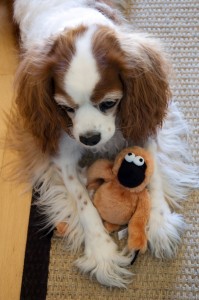 My eldest dog, Murphy, a female Cavalier King Charles Spaniel, is 13. We never expected her to make it to 3, but she’s vibrant and healthy.
My eldest dog, Murphy, a female Cavalier King Charles Spaniel, is 13. We never expected her to make it to 3, but she’s vibrant and healthy. It was a summer evening and the dogs and I were out for last call. A man and woman at the end of the block were standing next to the waist-high wall that bordered my neighbor’s steep property.
It was a summer evening and the dogs and I were out for last call. A man and woman at the end of the block were standing next to the waist-high wall that bordered my neighbor’s steep property.
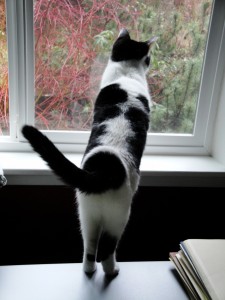 We live in a small condo: just me, two Cavalier spaniels (Murphy and Alki), and Grace the Cat. Well, okay, let’s include my crystal partner, Fallon, and Raymond, a fifty-something jade tree who spreads out like an oak.
We live in a small condo: just me, two Cavalier spaniels (Murphy and Alki), and Grace the Cat. Well, okay, let’s include my crystal partner, Fallon, and Raymond, a fifty-something jade tree who spreads out like an oak.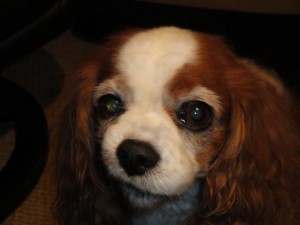 Have you always wanted to talk with an animal? And hear it talk back?
Have you always wanted to talk with an animal? And hear it talk back? Toys are a big part of the magical goofy fun side of family life. In our case, it’s a multi-species family life, which means we are a woman, two Cavaliers, and a goofy eight-pound cat.
Toys are a big part of the magical goofy fun side of family life. In our case, it’s a multi-species family life, which means we are a woman, two Cavaliers, and a goofy eight-pound cat. I was Cat’s Eye Writer’s first guest poster!
I was Cat’s Eye Writer’s first guest poster!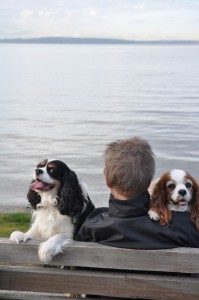 There are so many people doing animal communication that they’ve begun to specialize. I don’t do animal communication exclusively. I communicate with all life, from animals to businesses, homes, and nature, including wild/domestic land and weather systems.
There are so many people doing animal communication that they’ve begun to specialize. I don’t do animal communication exclusively. I communicate with all life, from animals to businesses, homes, and nature, including wild/domestic land and weather systems.





















